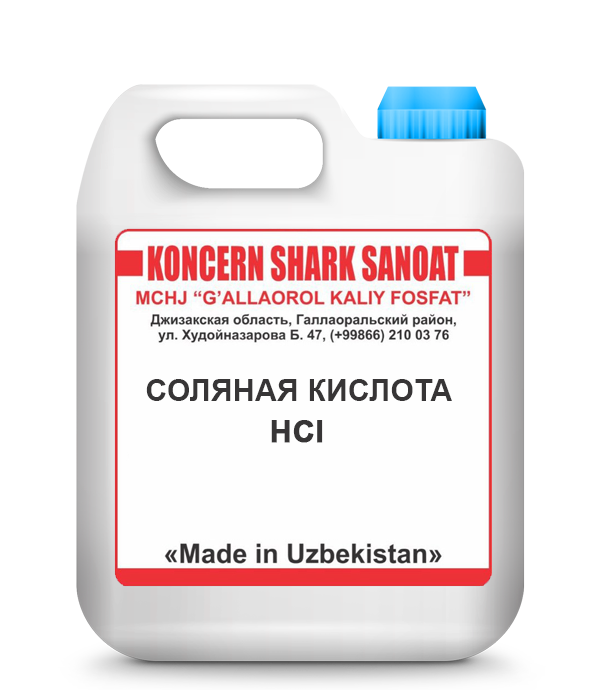
Hydrochloric acid is an inorganic substance, a monobasic acid, one of the strongest acids. Other names are also used: hydrogen chloride, hydrochloric acid, hydrochloric acid.
Characteristics and physical properties of hydrochloric acid
An aqueous solution of hydrogen chloride is called hydrochloric acid. Under normal conditions, it is a colorless liquid with a pungent odor.
Strong acid: pKa = -7.1. Concentrated hydrochloric acid contains about 37% HCl.
The main physical properties of hydrochloric acid are shown in the table:
| Melting point , o С | -thirty |
| Boiling point , o С | 48 |
| Enthalpy of formation, kJ / mol | -605.22 |
| Density, g / cm 3 | 1.19 |
| Specific heat, kJ / (kg × K) | 2.46 |
| Viscosity, MPa × s | 1.99 |
Getting hydrochloric acid
Hydrochloric acid is obtained by dissolving hydrogen chloride in water. Currently, the main method for the industrial production of hydrogen chloride is its synthesis from hydrogen and chlorine:
H 2 + Cl 2 = 2HCl + 183 kJ.
This process is carried out in special installations, in which a mixture of hydrogen and chlorine is continuously formed and immediately burns out with an even flame. Thus, a calm (without explosion) course of the reaction is achieved. Chlorine and hydrogen formed during the electrolysis of sodium chloride solution are the initial raw materials for the production of hydrogen chloride.
Large amounts of hydrochloric acid are also obtained as a by-product of the chlorination of organic compounds according to the reaction equation below:
RH + Cl 2 = R-Cl + HCl,
where R is a hydrocarbon radical.
Chemical properties of hydrochloric acid
Hydrochloric acid is a strong electrolyte. It has the following chemical properties common to all acids:
– the ability to interact with bases with the formation of salts:
HCl dilute + NaOH dilute = NaCl + H 2 O;
HCl dilute + NH 3 × H 2 O = NH 4 Cl + H 2 O;
– the ability to interact with some metals with the release of hydrogen (diluted solution):
2HCl dilute + Fe = FeCl 2 + H 2 ↑;
2HCl dilute + Zn = ZnCl 2 + H 2 ↑;
– the ability to enter into reactions of interaction with basic and amphoteric oxides with the formation of salts and water:
4HCl conc + MnO 2 = MnCl 2 + 2H 2 O + Cl 2 ↑;
4HCl conc + PbO2 = PbCl 2 ↓ + Cl 2 ↑ + 2H 2 O;
– the ability to interact with salts of weaker acids:
2HCl dilute + CaCO 3 = CaCl 2 + CO 2 ↑ + H 2 O;
– the ability to change the colors of indicators, in particular, to cause a red color of litmus;
When hydrochloric acid dissociates, hydrogen ions are formed:
HCl↔H + + Cl – .
Heating a mixture of solutions of hydrochloric and nitric acids to a temperature of 100-150 o C leads to the formation of a very strong oxidizing agent – a compound called “aqua regia”:
6HCl conc + 2HNO 3 conc = 2NO ↑ + 3Cl 2 ↑ + 4H 2 O.
Hydrochloric acid in redox reactions can act both as a reducing agent (due to the chloride anion Cl – ) and as an oxidizing agent (due to the hydrogen cation H + ). The ORP equations with the participation of hydrochloric acid are given below:
16HCl conc + 2KMnO 4 = 2MnCl 2 + 5Cl 2 ↑ + 8H 2 O + 2KCl;
14 HCl conc + K 2 Cr 2 O 7 = 2CrCl 3 + 3Cl 2 ↑ + 7H 2 O + 2KCl (t = 60 – 80 o C);
4 HCl conc + Ca (ClO) 2 = 2Cl 2 ↑ + CaCl 2 + 2H 2 O;
6 HCl conc + KClO 3 = 3Cl 2 ↑ + KCl + 3H 2 O.
Application of hydrochloric acid
Hydrochloric acid is one of the most important acids in chemical practice. The annual global production of hydrochloric acid is estimated at millions of tons. Many of its salts are also widely used.
Hydrochloric acid is used in such areas of the national economy as hydrometallurgy and electroplating, for pickling, pickling and tinning the surface of metals; food production, as an acidity regulator (additive E507); in medicine, as a medicine (mixture with the enzyme pepsin) for insufficient stomach acidity.

